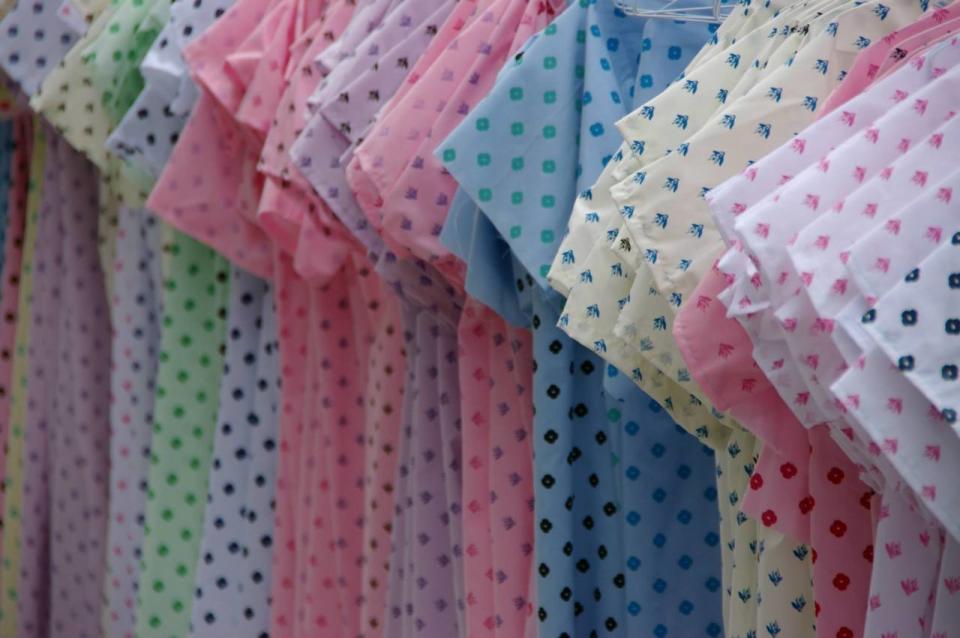Artist Makes Powerful Statement About Dangers of U.S. Maternity Care

Dying in childbirth is not something that most American women typically worry about. But perhaps it should be: The maternal mortality rate here is the highest of all developed nations — and recently saw an increase, putting the U.S. on a list with countries including war-torn Afghanistan. It’s a shocking reality that one artist wants people to know about.
STORY: Woman Sues Hospital Over Traumatic Birth That ‘Turned Our Family Life Upside Down’
“There’s this belief that United States is the best place in the entire world to have a baby, and that’s not true,” Chicago-based artist Michelle Hartney (pictured above) explains in a new trailer of her performance piece, “Mother’s Right,” which she kicked off in her home city in the fall. “It’s the most dangerous place in the developed world.” She bases that on World Health Organization statistics, which show that, since 1995, the maternal mortality rate in the United States has increased 160 percent — and also that African-American women are four times more likely to die in childbirth than Caucasian women are here. Causes of maternal deaths range from hemorrhaging and infection to anesthesia and medical errors.
STORY: Bullied, Powerless, and Defeated: 45 Women Share Their Striking Birth Stories
To illuminate these birth facts, Hartney displayed a rack of hand-sewn hospital gowns. “Along with local midwives, doulas, and volunteers, we sewed 1,200 hospital gowns, one for every mother who died in childbirth in America in 2013,” she explains on her website. “The fabric was silk-screened to look like hospital gown fabric, composed of tiny drawings created of the plant derivatives of the drugs that have been used on laboring women for the past 150 years.”

Photo: Facebook
For the performance, the premier of which took place on Labor Day in a public plaza, several pairs of women stood facing each other, folding the gowns into triangles the way the American flag is folded at a soldier’s funeral, “to also bring awareness to the number of women who are coming out of childbirth with the same psychological symptoms as men and women who are fighting wars,” she explains in the trailer video, posted on Dec. 21 (and at the bottom of this piece) and made in partnership with Great Big Story and Every Mother Counts. Hartney plans on staging more performances throughout 2016.
“Many of our routine practices, like continuous monitoring, and forcing mothers to give birth on their backs, are not based on scientific evidence. There are still a lot of doctors that are not doing what’s best for women,” she says. “I’m approaching these issues with my art,” she explains. “Art can hit you deeper than just reading a statistic on a page can.”

Photo: Facebook
Hartney says her artwork was inspired by the birth of her second child, which “just didn’t feel right” at various moments — such as when her doctor told her, “Lie on your back” when she was laboring on her side. That command was the genesis for another series, “Birth Words,” in which Hartney takes real phrases that have been said to laboring women by their doctors and creates large sewn versions of the words. “I’ve had people think that I made them up,” she says, “because it’s hard to believe that a doctor would say, ‘Suck it up and get over it,’ or ‘If you don’t shut up we will knock you out.’”
Another in-the-works series in “MOM$,” in which Hartney aims to illuminate the high cost of childbirth in the U.S. through a call to action — for women who have given birth in an American hospital to submit copies of their bills.

Photo: David Hartney
“The United States is the most expensive country in the world to have a baby,” she explains on her website. “Pregnancy and newborn care account for the highest payouts to insurance companies and Medicaid in the United States, with a total price tag of $50 billion for the cost of four million births in 2013. … Sadly, this high cost of healthcare does not translate into better outcomes for women or children.”
Finally, Hartney stresses that she’s not trying to be a critic, but a catalyst for change. “My artwork is not trying to say that doctors are bad or hospitals are bad. What I’m trying to say is that women need to know that they need to be informed when they’re going into childbirth,” she says. “I want my daughter, if she has a baby, to be giving birth in different circumstances than we are now. Women have a choice, and that knowledge can change the way that we are experiencing childbirth in the United States.”
(Top photo: Great Big Story/YouTube)
Please follow @YahooParenting on Facebook, Twitter, Instagram, and Pinterest. Have an interesting story to share about your family? Email us at YParenting (at) Yahoo.com.



